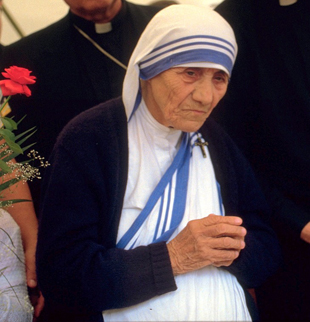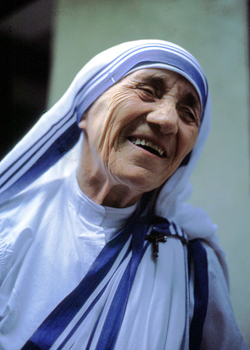For Sunday November 6, 2016
And All Saints Day
Lectionary Readings (Revised Common Lectionary, Year C)
Haggai 1:15b–2:9 or Job 19:23–27a
Psalm 145:1–5, 17–21 or Psalm 98 or Psalm 17:1–9
2 Thessalonians 2:1–5, 13–17
Luke 20:27–38
Back on September 4, at his Sunday mass in St. Peter's Square in Rome, Pope Francis canonized Agnes Gonxha Bojaxhiu (1910–1997) as a saint in the Catholic Church. Officially, she'll henceforth be called St. Teresa of Calcutta, although the Pope admitted that she'll probably be remembered as just Mother Teresa.
Speaking in Latin, Francis said that "after due deliberation and frequent prayer for divine assistance, and having sought the counsel of many of our brother bishops, we declare and define Blessed Teresa of Calcutta to be a saint, and we enroll her among the saints, decreeing that she is to be venerated as such by the whole church."
For All Saints Day this Tuesday November 1, I've been reflecting on the life and legacy of this remarkable believer.
To do that, I read the new book A Call to Mercy: Hearts to Love, Hands to Serve that was released on August 16 to coincide with Teresa's canonization and also the Vatican's Year of Mercy. The book is a compilation of writings by Teresa, edited by Brian Kolodiejchuk, a Canadian priest, the leader of her case for sainthood, and editor of an earlier book by Teresa called Come Be My Light (2007).
Mother Teresa was born in Skopje, the capital city of Macedonia (although part of the Ottoman Empire at the time), to Albanian parents who were deeply Catholic. As a little girl she felt a strong call of God upon her life to love Jesus, so it was no surprise when she joined the Sisters of Our Lady of Loreto in Dublin, Ireland, at the age of eighteen.
A year later, Agnes was sent to Darjeeling, India, where she taught young girls. By that time she had completed her vows, taken the name Teresa after Saints Teresa of Avila (1515–1582) and Thérèse of Lisieux (1873–1897), and was sent to Calcutta College for further studies. For the next fifteen years she taught history and geography at Saint Mary’s High School.
It was in the context of Calcutta's unimaginable poverty that on September 10, 1946, at the age of thirty-six, Teresa took her famous train ride. Traveling from Calcutta to Darjeeling for a retreat, God spoke very directly to her.
 |
She later wrote that this experience was more than a strong sense of call or a burden. Rather, Jesus spoke very directly to her in voices and visions: “Would you not help these poorest of the poor?” One year later, in August 1947, she left the convent to live in the slums with the wretched poor and dying. She traded her traditional habit for the ordinary dress of an Indian woman, her now famous white sari with a blue stripe.
Mother Teresa died of heart failure on September 5, 1997. In 2012, the Missionaries of Charity had over 4,500 nuns serving the poorest of the poor in 133 countries.
I'll always remember visiting the Sisters of Mercy home for the destitute and dying in Addis Ababa in February 2005. I was awed by the strength and grace of Sister Ignacia from Slovakia as she ministered to screaming kids, teenage mothers with newborn babies, the severely retarded, and adults dying of AIDS. At their orphanage, 400 HIV-positive children experienced the love of God.
Mother Teresa's many honors included the 1979 Nobel Peace Prize. At her burial on September 10, 1997, fifty one years to the day after that famous train ride, dignitaries from two dozen countries attended, but befitting her love of the poor, half of the seats in Netaji Stadium were reserved for those outcasts whom she served.
Similarly, at her canonization on September 4, nuns from the Missionaries of Charity led a processional of 1,500 homeless people through the gates of the Vatican to sit in seats of honor, along with 120,000 people who had gathered for the event.
As an icon of God's mercy, said Pope Francis in his homily, Mother Teresa “bowed down before those who were spent, left to die on the side of the road, seeing in them their God-given dignity.”
"She made her voice heard before the powers of the world, so that they might recognize their guilt for the crimes of poverty they themselves created." And in case anyone missed his point, he repeated himself, "the crimes of poverty."
"Mother Teresa, in all aspects of her life, was a generous dispenser of divine mercy, making herself available for everyone through her welcome and defense of human life, those unborn and those abandoned and discarded," he said.
"For Mother Teresa, mercy was the salt that gave flavor to her work, it was the light which shone in the darkness of the many who no longer had tears to shed for their poverty and suffering."
Teresa always instructed her sisters to do "small things with great love." That's a good beginning to living like a saint — material acts of mercy done in love.
But there's another aspect to Teresa's sainthood, said Francis. She not only shared the material poverty of the poor, she also entered their spiritual darkness. That's the theme of her controversial book Come Be My Light. Published to coincide with the tenth anniversary of her death, letter after letter documents the deep darkness that plagued Saint Teresa for fifty years.
She describes her interior struggles as an absence of God's presence — an emptiness, loneliness, pain, spiritual dryness, or lack of consolation. "There is so much contradiction in my soul, no faith, no love, no zeal… I find no words to express the depths of the darkness… My heart is so empty… so full of darkness… I don't pray any longer. The work holds no joy, no attraction, no zeal… I have no faith, I don't believe."
And what about her angelic demeanor that so many people experienced? "The smile is a big cloak that covers a multitude of pains… my cheerfulness is a cloak by which I cover the emptiness and misery… I deceive people with this weapon."
Time and again she admitted to her confessors that she felt like a "shameless hypocrite" for teaching and preaching one thing while experiencing something far different in her own life.
And so this second sign of saintliness: "If I'm going to be a saint, I'm going to be a saint of darkness, and I'll be asking from heaven to be the light of those who are in darkness on Earth."
 |
Mother Teresa was never bereft of an intense longing for God, and this was an important telltale sign. Eventually, she determined that her spiritual darkness was not an obstacle to her call from God to serve the poorest of the poor, but instead central to that call. In her darkness she identified with the poor and shared in the sufferings of Christ himself.
Given these two signs of saintliness, the material and the spiritual, Kolodiejchuk organizes A Call to Mercy around the seven corporal works of mercy — feed the hungry, give drink to the thirsty, clothe the naked, welcome the stranger (or shelter the homeless), heal the sick, visit the imprisoned, and bury the dead; and then the seven spiritual works of mercy — counsel the doubtful, instruct the ignorant, admonish sinners, comfort the afflicted, forgive offenses willingly, bear wrongs patiently, and pray for the living and the dead.
In sum, said Pope Francis in his September 4 homily, “may this tireless worker of mercy help us to increasingly understand that our only criterion for action is gratuitous love, free from every ideology and all obligations, offered freely to everyone without distinction of language, culture, race or religion."
“Her mission to the urban and existential peripheries remains for us today an eloquent witness to God’s closeness to the poorest of the poor,” said Francis. “Today, I pass on this emblematic figure of womanhood and of consecrated life to the whole world of volunteers: May she be your model of holiness!”
Image credits: (1) © 1986 Túrelio (via Wikimedia-Commons), 1986 / CC BY-SA 2.0 de; and (2) By Manfredo Ferrari (Own work) CC BY-SA 4.0.





